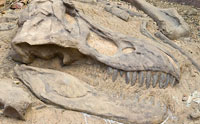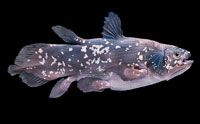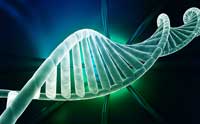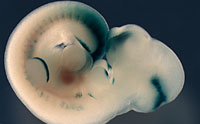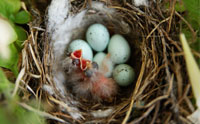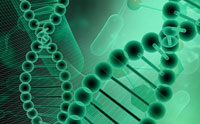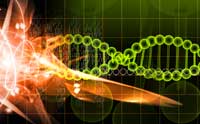They can ignore the fossils, ignore protein decay, or claim contamination. But all three tactics create far more problems than they solve. More… Read more here: icr.org
For over 50 years in a Russian experiment, foxes have been selected for one trait—tameness. The results have been fascinating. A population has resulted that is as tame as domestic dogs. These changes have been associated with changes in the neuroendocrine system, including lower levels of blood cortisol. Developmental changes have been seen as well. In addition to these traits seen throughout the population, other changes have appeared at a rate higher than would be expected by mutation alone. The most notable example is a white spotting pattern which often results in a star on the fox’s face. The types [More]
This discovery, like so many similar finds, truly embarrasses evolutionist's age assignments. More… Read more here: icr.org
This new data unequivocally proves that Neandertals and Denisovans were well within the DNA variability range of modern humans—not extinct primitive evolutionary offshoots of the human lineage. More… Read more here: icr.org
A recent report on the genome sequence of the so-called living fish fossil, the African coelacanth, has some evolutionists scrambling to defend their story. More… Read more here: icr.org
What is the difference between figure 1 and figure 2? Both are patterns of light and dark. Both are arrangements of the same 12 particular shapes in the same groupings. Both exhibit a complexity of arrangement. The probability of either arrangement arising by chance is similar. Neither arrangement has been produced by any action of the properties of the material they appear on. But there is a world of difference between the two, and that difference is equivalent to the difference between the imagined ‘primordial soup’1 of non-living chemicals, and a living cell. This is because a living cell is [More]
Once again, DNA sequence that was once thought to be nothing but a genomic fossil has shown itself to be vital to human survival. More… Read more here: icr.org
Natural selection is an observable process that is often purported to be the underlying mechanism of unobservable molecules-to-man evolution. The concepts are indeed different, though some mistakenly interchange the two. So let’s take a closer look. There are two major questions to answer: How do biblical creationists rightly view the observable phenomenon of natural selection? Could this process cause the increase in genetic information necessary for molecules-to-man evolution? What Is Natural Selection? Below are some definitions evolutionists use to define “natural selection.” The problem biblical creationists have with these definitions lies mostly in their misapplication, as noted by the bolded [More]
Several new studies show how plants adapt in different environments without changing their genetic code through a process known as “epigenetics.” More… Read more here: icr.org
Perhaps you might expect a boxfish to “swim as well as a barn would fly.” In fact, navy engineers are learning important lessons from them. Read more here: creation.com
Location is everything, and this same working principle applies to genes and their control sequences in the genome during embryo development. And not just simple location in a linear sense, but three-dimensional spatial location. More… Read more here: icr.org
By Ken Ham Yes, you read that title correctly—human intelligence has been on the decline (since the Fall of Genesis 3), and now a leading geneticist agrees. Dr. Gerald Crabtree recently stated in an article that he believes genetic mutations are adversely affecting human intelligence. In his article in the journal Trends in Genetics, Crabtree claimed, “I would wager that if an average citizen from Athens of 1000 BC were to appear suddenly among us, he or she would be among the brightest and most intellectually alive of our colleagues and companions, with a good memory, a broad range of [More]
Sir David Attenborough and Charles Darwin were both mistaken in their evaluation of the animals of the Galápagos as evidence for evolution. Read more here: creation.com
Bird fossils do not generally ruffle paleontologist's feathers, but some amazing specimens from China's Jehol province—preserving eggs inside fossil bird bodies—might do just that. More… Read more here: icr.org
Research has now shown that one of the key icons of human evolution, the beta-globin pseudogene, is functional and important to hemoglobin gene regulation. More… Read more here: icr.org
When scientists studied yeast and bacteria that “fail to optimize” the production of certain proteins, they discovered that's actually a very good thing. More… Read more here: icr.org
For the last 15 years, Dr Mary Schweitzer has been rocking the evolutionary/uniformitarian world with discoveries of soft tissue in dinosaur bones.1 These discoveries have included blood cells, blood vessels, and proteins like collagen. But under measured rates of decomposition, they could not have lasted for the presumed 65 million years Ma since dino extinction, even if they had been kept at freezing point never mind the much warmer climate proposed for the dinosaurs.2 As she said in a popular TV show: When you think about it, the laws of chemistry and biology and everything else that we know say [More]
One of the tired old canards on which antitheists have dined out for years is the claim that our eye is stupidly wired back to front, something no decent designer would use. E.g. the vociferous misotheist and eugenicist Clinton R. Dawkins said in his famous book, The Blind Watchmaker: Read More via Fibre optics in the eye.
If the regulatory picture of the genome was not complicated enough, now scientists have discovered yet one more amazing level of bio-complexity that involves a whole new class of molecules in the form of RNA hoops, or circles—the results just published in several new Nature papers.1, 2 In fact, the findings were so startling that one of the lead authors commented the molecules formed "a hidden, parallel universe" where many new types and functions remain to be discovered.3 Read More via Circular RNAs Increase Cell Bio-Complexity.
Green plants are a beautiful part of Earth’s environment, and they are essential for life. God created them on the 3rd day of Creation Week (Genesis 1:10–13), before animals, and even before the sun.1 At the beginning of creation, humans and all animals were herbivores (Genesis 1:29–30). Even now, plants are the basis of the food chain, because they don’t require their own food but make it from sunlight via photosynthesis. In this process, they also produce the oxygen (O2) which is essential for all air-breathing life. Photosynthesis is therefore one of the most important chemical reactions on Earth. If [More]
Researchers in Trinidad relocated guppies (Poecilia reticulata) from a waterfall pool teeming with predators to previously guppy-free pools above the falls where there was only one known possible predator (of small guppies only, therefore large guppies would be safe).1 The descendants of the transplanted guppies adjusted to their new circumstances by growing bigger, maturing later, and having fewer and bigger offspring. Tead More via Speedy species surprise.
This is a continuation of our response to the BBC’s recent series Wonders of Life, presented by Professor Brian Cox.1 The subtitle Endless forms most beautiful, is the title of Episode 3 of the BBC series and is taken from the last sentence of Darwin’s Origin of Species.2 Part 1 of our response can be found here. Evolution of the ear (Episode 2) Cox made the claim that certain bones in our ears had clearly evolved from reptilian ancestors and, before that, jawless fish that lived around 530 million years ago. These bones, known as the malleus, incus and stapes, [More]
Professor Brian Cox is a particle physicist at Manchester University in the UK, and is widely tipped to succeed David Attenborough as the BBC’s top presenter of popular science TV programmes.1 It is a position for which he has all the ‘right’ qualifications. In the 1990s, he played keyboards for the pop group D:Ream; he is considered the best looking physics professor around; and, most importantly, he has no time for the God of the Bible. As a ‘Distinguished Supporter’ of the British Humanist Association, he gave their 2010 Voltaire lecture entitled, The value of big science. In this he [More]
Much to the chagrin of evolutionists, the past decade of research has clearly shown that transposable elements play vital and purposeful roles in regulating how genes and the genome function. More… Read more here: icr.org
Photo by Eric Erbe, wikipedia Escherichia coli Low-temperature electron micrograph of a cluster of E. coli bacteria. Each individual bacterium is oblong shaped. by Shaun Doyle Published: 7 July 2011(GMT+10) Subsequently published in Journal of Creation 25(3) Beneficial mutations are often seen as the engine of evolution (Mutations: evolution’s engine becomes evolution’s end!). However, beneficial mutations by themselves don’t solve the problem (see Beetle Bloopers). Mutations not only have to be beneficial, but they have to add biological information, i.e. specified complexity. However, practically all beneficial mutations observed have been losses of specified complexity (The evolution train’s a-comin’), with [More]
by David Catchpoole Published: 2 April 2013 (GMT+10) ‘Vestigial’ organs have been used as an argument against a designer for many years, and have been used as a major ‘proof’ of evolution. But it has suffered repeated blows over the last few decades, with functions being found for most, if not all, of the over 180 organs listed as either vestigial or rudimentary by anatomist Robert Wiedersheim in 1893. So much so that an evolutionist observer wrote in New Scientist that ‘these days many biologists are extremely wary of talking about vestigial organs at all’ and that this ‘may be [More]
by David Catchpoole Locust The challenges confronting designers of small robotic aircraft are many. For example, fixed wings, like those used on passenger aircraft, become very inefficient in tiny robotic planes.1 So aeronautical engineers are looking at flapping wings as an alternative. Researchers at the University of Oxford (UK) and the Australian Defence Force Academy decided to study locust flight because locusts are such efficient flyers.2 Any artificial wing that isn’t modelled on the ‘optimised’ design of the insect wing is less efficient. “They can fly for a very long time, over long distances with very little energy,” explained lead [More]



















